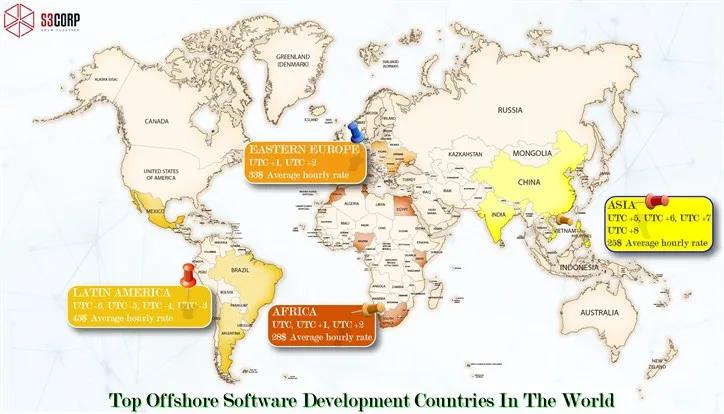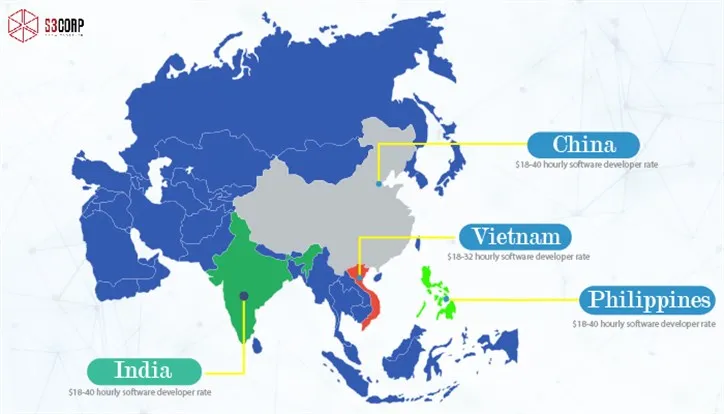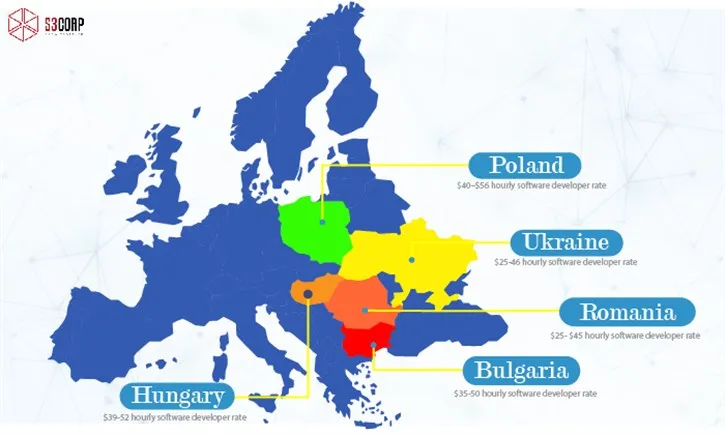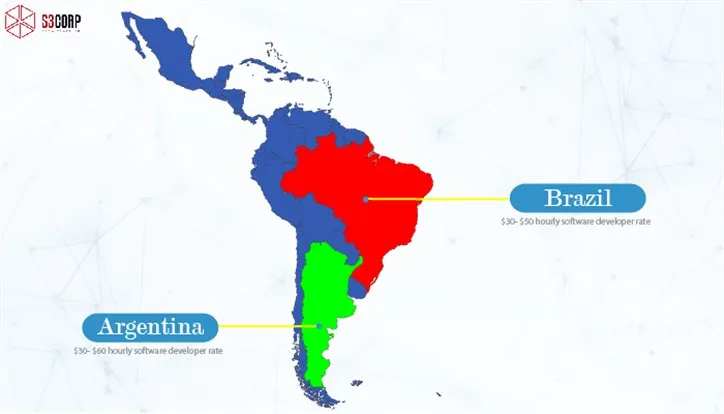Best Offshore Software Development Countries

Insights
Table Of Content
Quick Comparison Table: Top Offshore Development Countries 2026
How to Choose an Offshore Development Country
Best Offshore Software Development Countries: Detailed Profiles
Regional Comparison: Asia vs Eastern Europe vs Latin America
Best Country Based on Project Type
Offshore Development Rates Comparison by Cost Tier
Checklist to Pick the Right Offshore Development Country
Final Recommendation: Choose Offshore Development Country by Your Priorities
Conclusion
Frequently Asked Questions
A practical comparison of the 11 best offshore software development countries, covering rates, talent availability, English proficiency, and regional advantages to help you choose your development partner
25 Mar 2021
When you search for the best offshore software development countries, you want straight answers. Which country offers the best developers at rates that make sense for your budget? Where can you find engineers who understand your requirements without constant clarification?
This guide compares 11 leading offshore development destinations across five critical criteria: development costs, talent pool size, English proficiency, time zone compatibility, and technical strengths. We examine software outsourcing countries across Asia, Eastern Europe, and Latin America to give you a clear picture of what each location brings to the table.

|
Country |
Hourly Rate (USD) |
Talent Pool Size |
English Level |
Time Zone (vs. US EST) |
Core Strengths |
|
India |
$18-40 |
5M+ developers |
Moderate-High |
+10.5 hours |
Enterprise, fintech, large teams |
|
China |
$20-45 |
7M+ developers |
Moderate |
+12-13 hours |
AI, hardware integration, manufacturing tech |
|
Philippines |
$18-35 |
200K+ developers |
High |
+12-13 hours |
US cultural fit, customer-facing apps |
|
Vietnam |
$18-40 |
500K+ developers |
Moderate-High |
+12 hours |
Mobile, e-commerce, fintech |
|
Poland |
$35-70 |
430K+ developers |
High |
+6 hours |
Enterprise systems, banking |
|
Romania |
$30-60 |
180K+ developers |
High |
+7 hours |
Cybersecurity, cloud infrastructure |
|
Ukraine |
$30-65 |
285K+ developers |
High |
+7 hours |
AI/ML, blockchain, gaming |
|
Hungary |
$35-65 |
120K+ developers |
High |
+6 hours |
Automotive software, IoT |
|
Bulgaria |
$28-55 |
90K+ developers |
High |
+7 hours |
Gaming, SaaS platforms |
|
Argentina |
$30-60 |
140K+ developers |
High |
+1-2 hours |
Nearshore for US, agile teams |
|
Brazil |
$25-55 |
500K+ developers |
Moderate-High |
+1-3 hours |
Fintech, large-scale systems |
Picking between offshore software development countries depends on five factors working together.
Budget reality check. A $15,000 monthly budget gets you different team sizes in different countries. Eastern Europe delivers senior developers but fewer heads. Asia gives you larger teams at similar total cost.
Project complexity matters. Building a straightforward mobile app differs from architecting a distributed system handling millions of transactions. Countries with strong enterprise experience charge more because their developers have solved harder problems.
Communication requirements. Real-time collaboration needs time zone overlap. Projects requiring frequent calls favor Latin America nearshore software development for US companies. Asynchronous work suits Asia offshore development talent pool locations.
English proficiency directly impacts speed. High English levels mean fewer misunderstandings, faster requirement gathering, and clearer documentation. This factor becomes critical for complex projects where nuance matters.
Team scaling plans. Starting with three developers but planning to grow to twenty? Check whether countries can support your expansion without quality drops or rate increases.
Read More: Offshore Software Development Collaboration: Proven Strategies for Seamless Teamwork

Hourly Rates: $18-40
Talent Pool: Over 5 million software developers
English Level: Moderate to High (strong in tech communication)
Key Strengths: India dominates when you need large development teams fast. The country graduates 1.5 million engineering students annually, creating a massive pipeline of developers across all experience levels. Indian developers excel in enterprise software, financial technology, and complex backend systems. Cities like Bangalore, Hyderabad, and Pune host thousands of software companies, from startups to global tech giants.
The offshore developer rates by country comparison shows India offers exceptional value for enterprise-grade projects. You can assemble a 20-person team within weeks, something difficult in smaller markets. Indian developers bring experience with modern frameworks, cloud platforms, and agile methodologies.
Best For: Enterprise applications, large team requirements, long-term partnerships, and projects needing deep expertise in Java, Python, and cloud technologies.
Hourly Rates: $20-45
Talent Pool: Over 7 million developers
English Level: Moderate (improving rapidly in tech hubs)
Key Strengths: China leads in artificial intelligence, hardware-software integration, and manufacturing technology. Developers in Shenzhen, Beijing, and Shanghai work at the intersection of software and hardware, making them ideal for IoT projects, robotics, and consumer electronics.
Chinese developers show strong mathematical and algorithmic skills, particularly in machine learning and computer vision. The country invests heavily in technical education, producing graduates skilled in cutting-edge technologies. However, communication can require more structured documentation and clear specifications.
Best For: AI/ML projects, hardware integration, manufacturing software, and products targeting Asian markets.
Hourly Rates: $18-35
Talent Pool: Over 200,000 developers
English Level: High (American English proficiency)
Key Strengths: Filipino developers offer the best cultural fit for US companies among top IT outsourcing hubs in Asia. The country uses American English, celebrates similar holidays, and understands Western business practices deeply. This cultural alignment reduces friction in daily collaboration.
The Philippines excels in customer-facing applications, mobile development, and projects requiring strong communication with end users. Developers often have experience in BPO (business process outsourcing), giving them insight into business operations alongside technical skills.
Best For: Customer-facing applications, mobile apps, e-commerce platforms, and teams requiring frequent verbal communication.
Hourly Rates: $18-40
Talent Pool: Over 500,000 developers
English Level: Moderate to High (strongest among younger developers)
Key Strengths: Vietnam combines competitive pricing with rapidly improving technical capabilities. The country has become a software outsourcing powerhouse, with developers skilled in mobile development, web applications, and fintech solutions. Cities like Ho Chi Minh City and Hanoi host thriving tech communities with strong startup ecosystems.
Vietnamese developers demonstrate strong work ethic, loyalty to long-term partnerships, and quick adaptation to new technologies. The government actively supports the tech sector through education programs and infrastructure investments. Offshore outsourcing 2026 trends show Vietnam gaining market share from more established locations.
Best For: Mobile applications, e-commerce platforms, fintech solutions, and companies seeking stable long-term partnerships.

Hourly Rates: $35-70
Talent Pool: Over 430,000 developers
English Level: High
Key Strengths: Poland stands out in Eastern Europe for enterprise software development and banking systems. Polish developers bring strong computer science fundamentals, with many holding advanced degrees. The country hosts major R&D centers for global technology companies, indicating high developer quality.
Warsaw, Krakow, and Wroclaw offer sophisticated tech talent familiar with complex regulatory requirements, making them ideal for financial services and healthcare projects. Polish teams excel in creating maintainable, well-documented code for long-lived systems.
Best For: Enterprise systems, banking and financial services, healthcare applications, and projects requiring EU data compliance.
Hourly Rates: $30-60
Talent Pool: Over 180,000 developers
English Level: High
Key Strengths: Romania specializes in cybersecurity and cloud infrastructure development. Bucharest and Cluj-Napoca host vibrant tech scenes with developers skilled in modern DevOps practices, security protocols, and distributed systems architecture.
Romanian developers often have backgrounds in mathematics and cryptography, making them strong in security-critical applications. The best region for software outsourcing in Eastern Europe includes Romania for projects demanding high security standards.
Best For: Cybersecurity solutions, cloud infrastructure, SaaS platforms, and security-sensitive applications.
Hourly Rates: $30-65
Talent Pool: Over 285,000 developers (pre-conflict estimates)
English Level: High
Key Strengths: Ukrainian developers have earned a reputation for innovation in blockchain, AI/ML, and gaming. Despite ongoing challenges, the tech sector remains active, with many developers working remotely from safe locations or abroad.
Ukraine produces developers with strong algorithmic thinking and creative problem-solving abilities. The country has a deep pool of senior developers and technical leads experienced in complex projects.
Best For: Blockchain projects, AI/ML applications, gaming development, and companies comfortable with distributed remote teams.
Hourly Rates: $35-65
Talent Pool: Over 120,000 developers
English Level: High
Key Strengths: Hungary specializes in automotive software and IoT development. Budapest hosts numerous automotive R&D centers, creating developers experienced in embedded systems, real-time processing, and hardware-software integration.
Hungarian developers combine strong engineering education with practical experience in manufacturing and industrial applications. The country offers excellent intellectual property protection and EU regulatory compliance.
Best For: Automotive software, IoT solutions, embedded systems, and industrial automation.
Hourly Rates: $28-55
Talent Pool: Over 90,000 developers
English Level: High
Key Strengths: Bulgaria has become a hub for gaming development and SaaS platforms. Sofia hosts numerous game studios and product companies, creating developers skilled in graphics programming, real-time systems, and user experience.
Bulgarian developers offer lower rates than Western European countries while maintaining high quality. The offshore software development cost comparison shows Bulgaria providing excellent value in Eastern Europe.
Best For: Gaming development, SaaS products, graphics-intensive applications, and startups watching budgets.

Hourly Rates: $30-60
Talent Pool: Over 140,000 developers
English Level: High
Key Strengths: Argentina offers nearshore advantages for North American companies. Buenos Aires developers work in time zones overlapping with US business hours, enabling real-time collaboration impossible with Asian teams.
Argentine developers embrace agile methodologies and show strong cultural alignment with US business practices. The country produces creative problem solvers comfortable with ambiguity and iteration.
Best For: Nearshore projects for US companies, agile development teams, and projects requiring real-time collaboration.
Hourly Rates: $25-55
Talent Pool: Over 500,000 developers
English Level: Moderate to High (improving in tech sector)
Key Strengths: Brazil has Latin America's largest developer community, offering scale comparable to India at nearshore time zones. São Paulo and Florianópolis host mature tech ecosystems with experience serving global clients.
Brazilian developers excel in fintech, having built solutions for the country's advanced digital banking sector. They bring experience with high-transaction systems and payment processing.
Best For: Large-scale systems, fintech applications, nearshore teams for Americas, and projects requiring significant team sizes.
Different regions offer distinct advantages when comparing offshore software development countries.
|
Region |
Cost Range |
Time Zone (US) |
Key Strengths |
Key Challenges |
|
Asia |
$18-45/hour |
+10-13 hours |
Largest talent pools, lowest costs, strong technical skills, massive scaling capability |
Limited time overlap, cultural differences, communication requires more documentation |
|
Eastern Europe |
$28-70/hour |
+6-7 hours |
High English proficiency, strong computer science education, EU compliance, excellent for enterprise |
Higher costs, smaller talent pools, limited availability of junior developers |
|
Latin America |
$25-60/hour |
+1-3 hours |
Real-time collaboration, cultural fit with US, nearshore benefits, agile methodology adoption |
Smaller talent pools than Asia, mid-range pricing, fewer developers in cutting-edge specializations |
When Asia wins: Projects prioritizing cost efficiency, needing large teams, or following asynchronous workflows. Asia offshore development talent pool sizes enable rapid scaling.
When Eastern Europe wins: Enterprise projects requiring high compliance standards, sophisticated architecture, or EU market focus. Eastern European developers excel in complex, long-lived systems.
When Latin America wins: US companies needing daily collaboration, startups requiring agile flexibility, or projects where real-time communication drives success.
Read More: Offshore Development Center Model Explained
Matching countries to project types improves outcomes.
Best for Enterprise Systems: Poland and India lead for complex enterprise applications. Polish developers bring EU compliance expertise and architectural sophistication. Indian teams offer scale and experience with global enterprise platforms.
Best for Cost-Efficient Development: Vietnam, Philippines, and Bulgaria deliver strong quality at competitive rates. These countries offer the best offshore software development cost comparison results for budget-conscious projects without sacrificing reliability.
Best for AI and Emerging Tech: China, Ukraine, and India excel in artificial intelligence and machine learning. China leads in computer vision and hardware-AI integration. Ukraine specializes in innovative algorithms and blockchain. India offers large teams for AI implementation at scale.
Best for US Time Zone Alignment: Argentina and Brazil provide nearshore advantages with real-time collaboration potential. These Latin America nearshore software development locations eliminate the overnight wait for responses that Asian partnerships create.
Best for Rapid Team Scaling: India, Vietnam, and Brazil offer the talent pool depth needed to grow from five developers to fifty quickly. Their large developer populations prevent quality drops during rapid expansion.
Understanding rate tiers helps budget planning.
Low-Cost Range ($18-30/hour):
This tier works for straightforward projects, MVP development, or when maximizing team size matters more than individual seniority.
Mid-Range ($30-50/hour):
This tier balances experience with cost effectiveness. You get senior developers from Asian countries or mid-level talent from Eastern Europe and Latin America.
High-End ($50-70/hour):
This tier delivers architects, technical leads, and specialists in cutting-edge technologies. Still significantly below US rates ($100-200/hour) while maintaining exceptional quality.
Use this framework to compare offshore development rates and capabilities:
Budget and Scale
Technical Requirements
Communication Needs
Project Duration
Compliance and Security
Risk Management
No single country wins every category when you compare offshore development rates and capabilities.
Choose Asia when: Cost efficiency drives decisions, you need large teams, your project follows clear specifications, or asynchronous communication works for your workflow. India suits enterprise scale. Vietnam balances cost and quality. Philippines offers cultural fit. China excels in AI and hardware integration.
Choose Eastern Europe when: Project complexity demands sophisticated architecture, EU compliance matters, you need high English proficiency, or moderate time zone differences help collaboration. Poland leads in enterprise systems. Ukraine innovates in emerging tech. Romania specializes in security. Hungary excels in automotive and IoT.
Choose Latin America when: Real-time collaboration drives success, you need nearshore advantages, agile methodology flexibility matters, or your team culture values direct communication. Argentina offers best time zone overlap for US companies. Brazil provides scale with nearshore benefits.
Vietnam offers balanced value for companies seeking competitive offshore software development countries with strong technical capabilities, reasonable rates, and stable partnerships. The country combines Asia's cost advantages with growing expertise in modern technologies, making it strong for mobile development, e-commerce, and fintech projects.
The best offshore development destinations for 2026 depends on weighting these factors according to your specific situation. Most successful companies eventually partner with multiple countries, using each for its strengths. Start with one location matching your primary need, then expand strategically as you learn what works for your projects.
This article provided information on the best offshore software development hubs around the globe.
These countries are all worth your consideration. Some countries offer lower rates while others provide better quality. Hence, to figuring out the software vendor that you can partner with and establish a long-term working relationship, you should take time to do some more researches and discuss with your business team to choose the best one.
Here are some aspects that you might need to consider: your needs and requirements, the locations, language proficiency, development rates, technical capabilities, quality of education, culture. And so on.
In our experience, by limiting your research destinations, you will get more chances to find out the best offshore software outsourcing countries for your business needs. The following countries might be valid options for your software development needs: China, Ukraine, Poland, India, and Vietnam.
As a trusted Vietnam software outsourcing partner, our motto at S3Corp. is 'grow together. We believe that IT outsourcing is about sharing common goals and strive for success. Together we can help your business grow with the help of the latest technology and a professional team. Reach out with any questions relating to the topic or your software project.

No single country wins for all projects. India offers the largest talent pool and best rates for enterprise scale. Poland provides sophisticated developers for complex systems. Vietnam balances cost and quality. Argentina gives nearshore advantages for US companies. Choose based on your specific requirements for cost, communication, and technical capabilities.
India, Vietnam, and Philippines typically offer the lowest offshore developer rates by country, ranging from $18-40 per hour. However, total project cost depends on efficiency, communication overhead, and developer productivity. A $25/hour developer who works efficiently may cost less than a $20/hour developer requiring constant clarification.
Yes, rates continue rising gradually in established offshore software development countries. India's rates have increased 8-12% over three years. Vietnam and Eastern European countries see similar trends as demand grows. However, rates remain significantly below US and Western European levels. New locations emerge to fill lower-cost tiers as established markets mature.
Eastern European countries within the EU offer strongest intellectual property protection, with Poland, Romania, and Hungary providing robust legal frameworks. India has improved IP protection significantly with better enforcement of technology patents and copyrights. When choosing software outsourcing countries, include comprehensive contracts regardless of location, use code repositories with access controls, and implement security best practices throughout development.
Whether you have any questions, or wish to get a quote for your project, or require further information about what we can offer you, please do not hesitate to contact us.
Contact us Need a reliable software development partner?
S3Corp. offers comprehensive software development outsourcing services ranging from software development to software verification and maintenance for a wide variety of industries and technologies
Software Development Center
Headquater 307
307/12 Nguyen Van Troi, Tan Son Hoa Ward, Ho Chi Minh City, Vietnam
Office 146
3rd floor, SFC Building, 146E Nguyen Dinh Chinh, Phu Nhuan Ward, HCMC
Tien Giang (Branch)
1st floor, Zone C, Mekong Innovation Technology Park - Tan My Chanh Commune, My Phong Ward, Dong Thap Province
_1746790910898.webp?w=384&q=75)
_1746790956049.webp?w=384&q=75)
_1746790970871.webp?w=384&q=75)
